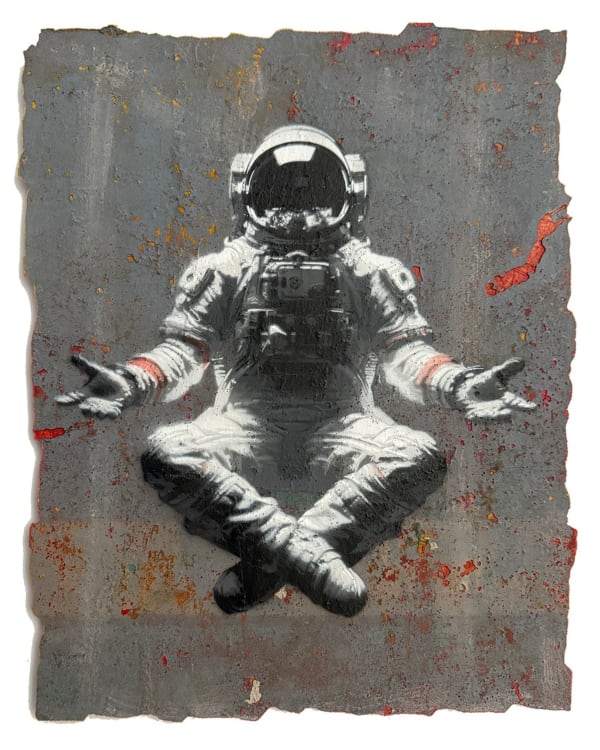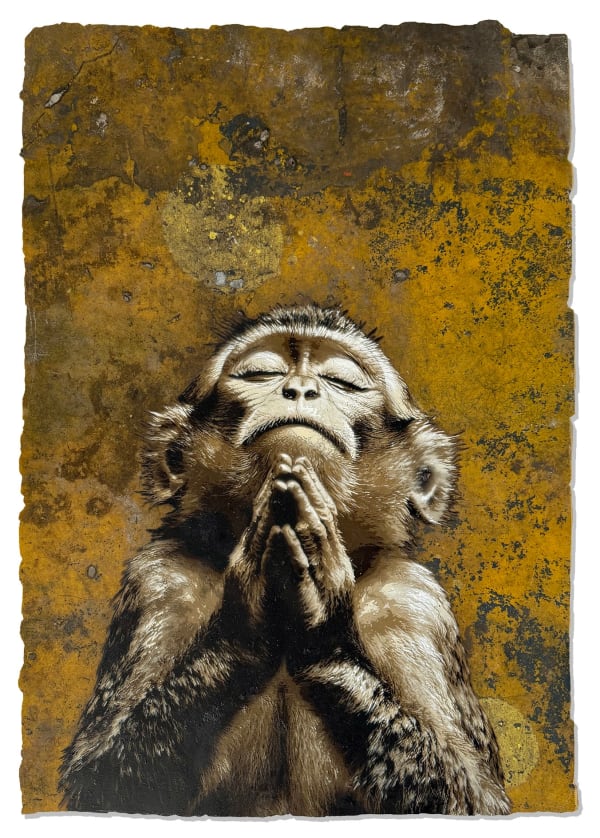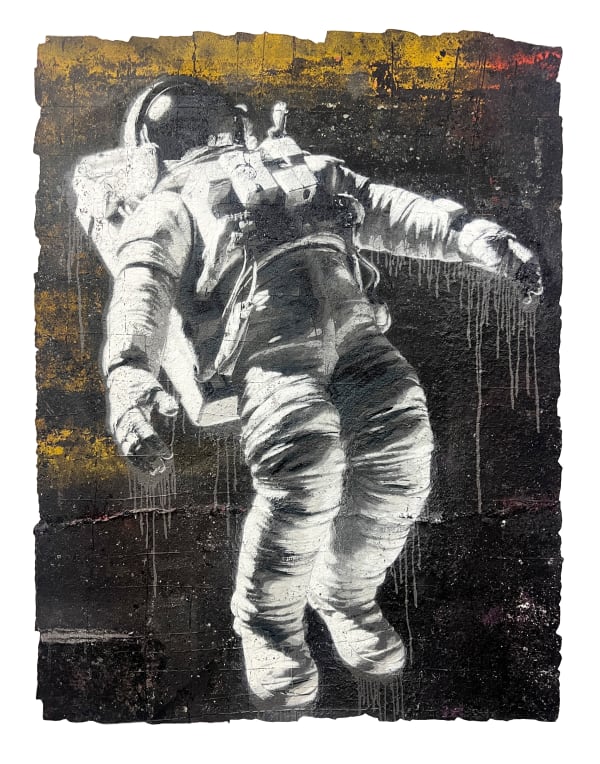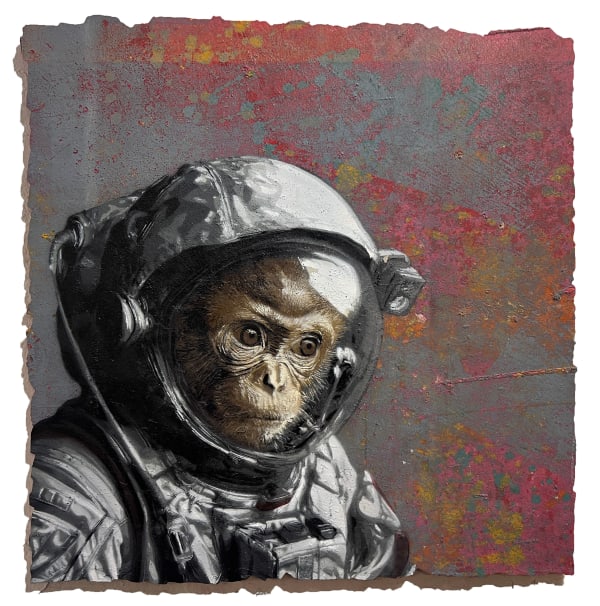Urban Fusion: Luke Cornish x Christophe Domergue
“a self-described introvert looking outwards, working with Domergue, an extrovert looking inwards"
Dichotomy and difference; similarity and synergy.
Elk: “a self-described introvert looking outwards, working with Domergue, an extrovert looking inwards”.
Two painters, divergent in practice, subject matter, process and philosophy, whose collaboration produces such synergy precisely because of their respective differences. That is to say a collaboration of dichotomy and difference, similarity and synergy.
Both have pushed their respective practices above and beyond ‘limitation’. Whilst stencilling necessitates a limited colour palette, Elk’s ambitious, complex works are limited in name only, and his precise, detailed compositions have earned him critical acclaim as Australia’s premier stencil artist. His astronauts, however, mark a departure from some of his more unmissably overt political commentary, instead striking a contemplative, existential tone, which compliments Domergue’s work.
Meanwhile, Domergue’s innovative “peeling” process involves the application of pigmented resin directly to carefully chosen urban surfaces, which he gravitates towards. After curing, Domergue peels up these resin works, which bring with them tangible pieces of ground and strata. As with Elk, Domergue’s practice is defined by the nature of the urban environments in which he intervenes to produce his “peelings”. However, his ability to identify compositions in these places means his peelings are limited only by the ground beneath his feet.
Matching Elk’s political subversion, Domergue’s striking compositions subvert landscape painting itself; in the absence of a clearly defined traditional scene, we realise we are looking not at a macro landscape but at a microcosm of the beauty to be found in our everyday surrounds; an eye for beauty that street artists share.
Art of the street; Art from the street
As an artist drawn to urban surfaces as the ‘ground’ for his paintings, it is little wonder ELK gravitated towards Domergue, who is himself drawn to rendering those surfaces and elevating them from street and factory floor to gallery wall – a trajectory not unfamiliar to a commercially successful street artist.
Whether for the same reasons or not, the artists have a shared affinity for particular spaces, and so Elk and Domergue’s collaborations thus speak to space and identity, not only cosmologically, but in terms of physical place, and belonging.
Firstly, the two share a DIY background, not only in terms of their experimental artistic practices, but, at a fundamental level, in terms of their respective subcultural origins, which inform and underpin their practices: street art, for E.L.K, and Sydney’s 90’s rave scene for Domergue.
Both subcultures at their core are premised upon the DIY. From its earliest iterations from the 1960s and 70s onwards, graffiti was the product of urban youth coopting new materials (such as spray paint) to make their mark. At the same time, there were those coopting records, sound systems and other technologies and creating something altogether new with them; their mark on history still resonates today, from disco to house to techno.
Therefore, both burgeoning subcultures took preexisting commodities – produced and made increasingly available, accessible and ‘everyday’ by increased industrialisation – and used them to create something entirely new. Ironically, the same material conditions that saw the proliferation of these commodities, disenfranchised many. The origin of the term ‘subculture’, pejoratively describing the subaltern, is a reminder of the socially, economically, racially and sexually marginalised status of many subcultural pioneers.
Perhaps it is because of the marginalised status of subcultural pioneers, both graffiti and rave subcultures’ relationship to space was similarly DIY, in that they took a space and ran with it. Graffiti, and later street art took public space as just that – public – and converted trains, walls, and the walls of toilet stalls, into public forums. Whether the statement was overtly political or marked a fleeting moment in time as to say “I was here”, public spaces have been permanently reimagined. Raves similarly coopted space – public and private – turning warehouses, factories, train stations and more into ad hoc venues to congregate, where communities were built under the cover of darkness, fuelled by psychoactive innovations in chemistry.
Marginalised, frowned upon, persecuted or prosecuted, it is little wonder both subcultures gravitated originally to forgotten spaces, with subterranean subway tunnels, or abandoned buildings, as their sanctuaries. In these forbidden spaces, alternative identities and alter egos were allowed to flourish. This act of spatial co-option remains an enduring legacy. The illegality of these actions is perhaps the most significant contribution of their respective subculture’s innovations. Asking neither for permission nor forgiveness, both subcultures have been vindicated in hindsight, and retrospectively forgiven, as ‘street art’ sells in auction houses and ‘electronic music’ tops the charts.
The sense of the outsider prevails...
Inevitably, subcultures are subsumed by the dominant culture they rallied against. But what do you do about it? There are equally valid reasons to embrace or to resent this, but each confront us with difficult questions. Do we relish the acceptance of street art, and enjoy modern cities adorned by murals? Or do we resent the ‘theft’ of prominent artists’ works hours or days after they appear upon the street? And are we satisfied with the ‘solution’: the preservation of certain artworks behind plexiglass, whilst ‘less legitimate’ ‘graffiti’ is painted over (and those creating it are prosecuted)?
Do we celebrate electronic music’s elevation in the public consciousness and the success of its artists? Or, as with jazz, blues and hip hop (to name but a few), do we resent yet another musical innovation pioneered by sociocultural minorities being capitalised upon by music industry executives, at the expense of artists, no less?
There are no straightforward, easy or singular answers to these questions – but nor should there be to questions worth asking, as with any good science fiction. Indeed, it is not these questions, per se, Domergue and ELK ask us – but they are everyday existential questions, with a profundity to be found in their ambiguity, just like those posed by the duo’s work.
In the duo’s work, moments of despair and fragility contend with tongue-in-cheek humour and optimism. Domergue’s urban galaxies and Elk’s ethereal astronauts at times are evocative of alienation and isolation, and yet love and solidarity; others are seemingly in peril, yet also safe inside their suits. At once referring to the milieu of existential crises in which we live, perhaps the astronauts offer hope that we can make it off this rock. Are they flying? Are they falling? Or are they simply floating in limbo? And what better setting to underscore the absurd futility of answering such impossible questions than the silent vacuum of space, where no one will hear your answer.
A recurring motif in science fiction and space exploration narratives is the image of primates in space, used as a metaphor for humanity’s evolutionary journey. Perhaps the most iconic example is Stanley Kubrick’s 2001: A Space Odyssey, in which an ape’s discovery of a monolith symbolizes the dawn of human intelligence. This theme highlights the idea that, despite our technological advancements, we are still bound by our primal nature—our aggression, our territorialism, and our struggle for dominance.
Even in real-world space exploration, primates played a role in early missions, with monkeys and chimps sent into orbit to test the viability of human space travel. This historical reality underscores an ironic contrast: we view ourselves as explorers venturing into the unknown, yet we remain fundamentally similar to our primate ancestors, driven by instinct and survival. In considering this, one must wonder whether our advancements in space are a true evolution of our species or merely an extension of our territorial expansion, akin to apes claiming new ground.
- Austin Kennedy Bates, 2024
























